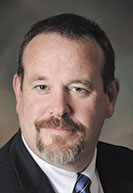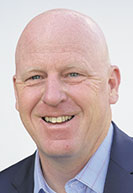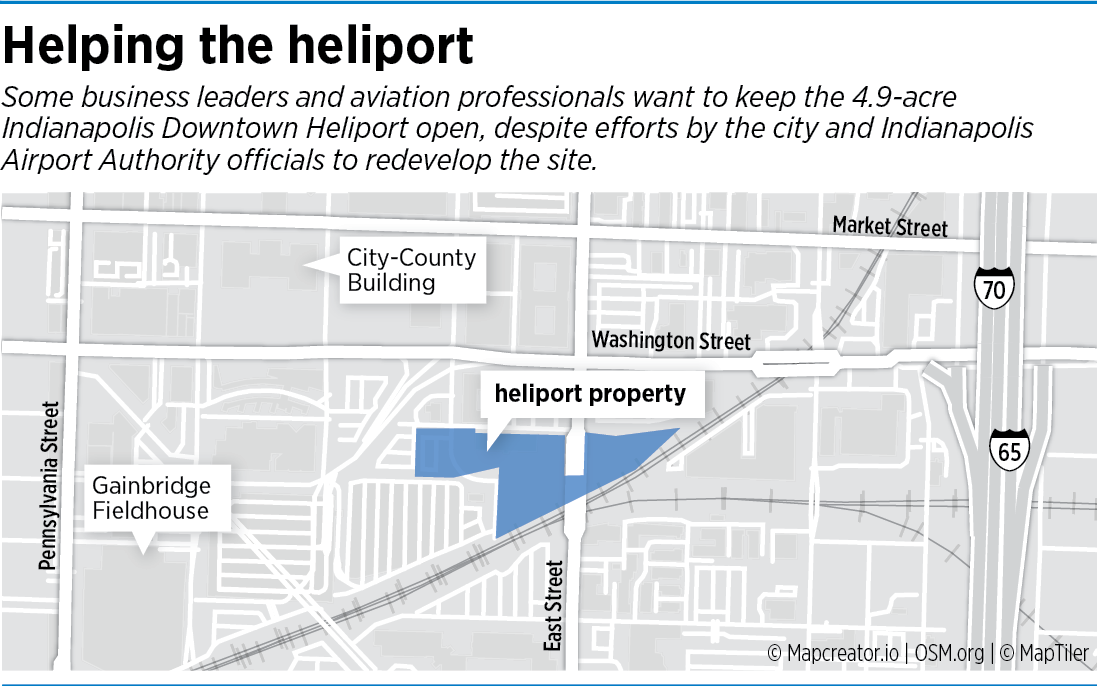Subscriber Benefit
As a subscriber you can listen to articles at work, in the car, or while you work out. Subscribe Now
Is the Indianapolis Downtown Heliport an impediment to development in the Market East Cultural District, one of the city’s fastest-growing neighborhoods for apartments and residential amenities?
Or is it a key asset in the future of the city’s aviation landscape, maybe even a future hub for air taxis?
Those are among the questions Mayor Joe Hogsett’s administration will try to answer as the city embarks on an analysis of the 4.9-acre property at 51 S. New Jersey St.
The Indianapolis Airport Authority has already asked the Federal Aviation Administration for permission to decommission the heliport, citing reduced use and an annual operating expense topping $735,000.
But a group of business leaders, aviation experts and the Indiana Department of Transportation are urging the airport authority to reconsider. They say the site will become an asset as electric aircraft that can take off and land vertically—called eVTOLs—become commonplace. And they’ve called on city officials to reconsider plans to redevelop the site.
“The future is bright for aviation in Indiana including concepts such as urban air mobility and eVTOL operations,” wrote Martin Blake, INDOT’s manager of aviation, in a 2021 letter addressing the airport authority’s plans. “This facility has potential in this space over the next few years as research develops.
“A conversion to non-aeronautical use of this valuable aviation infrastructure at the Indianapolis Heliport is not in the best interest” of the state, he said.
Indianapolis is on a short list of cities in the United States with a downtown heliport open to public uses, according to the FAA. Other cities that have one include Dallas; Fort Lauderdale, Florida; New York; Portland, Oregon; and St. Louis.
But as advanced air mobility—a concept for cargo and passenger services that includes drones and vertical take-off aircraft—grows in popularity, experts project that other major cities will pursue aviation infrastructure. Indianapolis, advocates argue, will be ahead of those cities if it keeps the heliport open.
Daniel Mojica, executive director of the privately operated Vertiport Chicago, said it “doesn’t make sense” for a city to abandon a downtown heliport given the advancements on the way.
Declining use
In the meantime, however, the Indianapolis Downtown Heliport sits lightly used.
The FAA doesn’t require the airport authority to track heliport flights. But officials say that, based on visible activity, fuel sales and a computerized after-hours door lock system, the facility’s recent usage has been “limited.”
According to INDOT data, the heliport’s usage declined 50% from 2010 to 2019, the most recent year for which data is available.
The height of the heliport’s popularity was in the early 1990s, with an average of 4,589 operations annually from 1992 to 1996. Usage has dropped 68% since operations peaked at 5,300 in 1992, INDOT reports.
Most TV stations and police no longer use helicopters. That’s left Indiana University Health’s LifeLine as the heliport’s only tenant—and airport officials are working with the health care system to find a new base of operations.
Meanwhile, the airport authority says the heliport cost it $735,470 to operate in 2022, and the property has required $3.96 million in capital investment since 2012.
“INDOT acknowledges that the Indianapolis Downtown Heliport is currently underutilized, but also recognizes potential opportunities related to advancing aviation in Indiana,” a spokesperson for INDOT said in an emailed statement.
In 2021, the city and the airport authority signed an agreement that would allow the city to redevelop the property after its decommissioning. But facing opposition to that plan—from advocates of advanced aviation technology as well as companies who want to use the heliport for charter flights now—city officials say they are reconsidering.

“The Indianapolis Airport Authority undertook an analysis more than a year ago and made the determination that it was not in their financial best interest to continue to operate a downtown heliport as a public entity,” Mark Bode, the mayor’s director of communications, said in written remarks.
“While we respect that conclusion, the city is undertaking its own analysis of the benefits and challenges presented by continued downtown heliport operations, generally. As part of that, the city intends to retain consultants who will engage with stakeholders in the coming months. We expect to receive recommendations well before any final decision on the downtown heliport is made by the Indianapolis Airport Authority.”
IBJ has requested a copy of the airport authority’s analysis but has not received it.
An alternative route
Although no commercial eVTOL vehicles have been deployed yet for public use—companies are still working with the FAA to ensure their safety—nearly $15 billion has been invested in the technology since 2015, according to New York-based management consulting firm McKinsey & Co. EVTOLs take off like helicopters but fly more like planes, and many companies have designs in the testing phase.
And at least at first, the vehicles will have limited uses. Current estimates peg the range for commercial eVTOLs now in testing at 100 miles; one would be able to travel from Indianapolis to Fort Wayne with about 10 miles to spare.
Still, advanced aviation companies are already striking deals in other cities.
Vertiport Chicago, in the city’s downtown Illinois Medical District, in March partnered with United Airlines to establish a commercial electric-based air taxi route from O’Hare International Airport starting in 2025. It will be Chicago’s first such route and will use California-based Archer Aviation eVTOLs to take clients from the West Loop neighborhood to the airport in 10 minutes.
The deal in Chicago follows a similar agreement for air taxi service that will see Archer ferry users between the Downtown Manhattan Heliport in New York City and Newark Liberty International Airport, also starting in 2025.
Representatives for Archer did not return an email requesting comment for this story.
But Archer is one of several eVTOL companies to sign a letter to the Indianapolis Airport Authority last month asking it to reconsider plans to close the downtown heliport. It is also partnering with Netherlands-based automotive manufacturer Stellantis—which last year announced plans to build a $2.5 billion electric vehicle battery plant in Kokomo—to build its aircraft.
Mojica of Vertiport Chicago said Indianapolis’ giving up its heliport would be a mistake.
“It doesn’t make sense for any city that already has this incredible infrastructure that is conveniently located, to step on their own feet, on their own toes, and destroy something that hundreds of cities within the next few years will be fighting to build and help push innovation forward,” he said.
But Mike Boyd, an aviation consultant and president of Colorado-based Boyd Group International, dismissed the idea that Indianapolis needs to hang on to the heliport to accommodate future technology, especially given the possibilities for redevelopment.
He said eVTOL development continues to deal with challenges in battery procurement and semiconductor technology, as well as safety questions about having such machinery flying in uncontrolled airspace at heights that are typically lower than most aircraft.
“I love the concept; don’t get me wrong. You’re walking down the street in Indianapolis, and seven minutes later, you’re at Indianapolis International or 20 minutes later, you’re in Fort Wayne. It’s a neat idea” he said.
“I’m not arguing with what these things could do,” he said. “I’m arguing with whether they will work, whether we have the technology to make them work.”
Needed now?
Some air industry leaders say the heliport could be better used now, without waiting on future technology.

Chuck Surack of Fort Wayne, who owns several aviation companies, told IBJ he would be interested in purchasing the heliport to ensure it remains operational and available for the next wave of aviation technology. He’s helping to lead opposition to the heliport’s closure.
“I think it’s a great asset for the state of Indiana,” said Surack, who also owns aviation charter company Sweet Helicopters. “It’ll never make any money for me, but that’s not my motivation. I think it’d be a real shame to tear it down, so I’m willing to lease it, rent it, buy it—whatever.”
Through its agreement with the city of Indianapolis, which is in effect until 2025, the heliport must be decommissioned before any request for proposals can be made for its redevelopment. It also cannot be marketed, put out for bid or sold until it is decommissioned, according to the airport authority.
But Randy Sharkey, chief pilot for Sweet Helicopters, said figuring out a way to transfer the property to a private operator like Surack would be a “win-win” for the airport authority and potential users—including Sweet, which provides transportation service to the heliport for major sporting events in Indianapolis as well as business meetings and other activities.
Sharkey said a bullish private operator of the heliport should be able to secure 4,000 takeoffs and landings annually by medical users, air taxis, recreational fliers, aerial tours and others.
“The downtown Indianapolis Heliport is in the heart of the business district and will serve as the perfect transit hub for urban air mobility,” he said in written remarks. “To forfeit this location would be a mistake that the city … would regret for years to come.”
The heliport opened in 1969 as privately operated Beeline Heliport. Its property is bounded by Maryland Street on the west, Pearl Street to the north and an active set of railroad tracks to the east and south. It’s surrounded by a 5.3-acre parking lot, a few smaller surface lots and a Best Western Plus hotel, along with a 2.5-acre parcel owned by a Surack holding company immediately to the east. Most of that land can’t be extensively developed due to its proximity to the heliport.
If the site is made available for reuse, it’s likely to get a lot of attention from developers, particularly those with a vision that incorporates neighboring parcels or the former Marion County Jail.
In 2017, investors tried to acquire the heliport to develop a $40 million project with apartments, retail, a 107-room limited-service hotel and a parking garage. Separately, Indianapolis’ bid for Amazon’s HQ2 proposed building office and residential space on the property.
Both ideas fizzled after the groups faced challenges in securing neighboring property.

Rex Alexander, president of Fort Wayne-based heliport infrastructure company Five-Alpha LLC, said the airport authority “has been running [the facility] as an airport, and it’s not an airport; it’s a heliport. They’ve never really [gone] out of their way to bring in new clients or new tenants.”
He said that, by signaling the heliport’s closure, the airport authority is driving away aviation and eVTOL groups that might have had an interest in using Indianapolis as a test site.
“The heliport does need improvements, and it does need work. But the footprint, the location, the airspace—those can never be duplicated if you get rid of it,” Alexander said. “There’s no place else in the downtown area in Indianapolis that can even come close to that.”
Moving ahead
Other cities worldwide are moving ahead. Paris is in the process of developing a series of vertiports ahead of the 2024 Summer Olympics. Vertiports are mainly intended to accommodate electric-based flying taxis, including eVTOLs. They are viewed as a successor of sorts to traditional heliports. (Vertiport Chicago is classified as a heliport, despite its name, which was assigned before the rise in eVTOLs.)
The Paris plan calls for using 10 aircraft from the company Volocopter to shuttle passengers between the city’s international airports and the city center, along with other destinations that would provide access to Olympic activities.
The project is being developed in partnership with UK-based heliport and vertiport infrastructure firm Skyports, which has expressed support in keeping the Indianapolis heliport open.

Paul Brooks, government and regulatory affairs manager for Skyports, said the group sees great value in the heliport as it relates to emerging technologies.
“We need to continue to protect [existing] infrastructure, because it’s going to be key to implementing advanced air mobility and new technologies as they become available, which is going to help spur urban growth in different ways,” Brooks said. “We’d love to see vertiports in all major U.S. cities, where it becomes part of the transportation network of the city.”
As part of that effort, he said, Skyports is working with manufacturers to identify and prepare potential spots for growth across the globe, including cities that already have heliports that could be linchpins in a nationwide network.
He said redeveloping the downtown heliport would mean “losing a potential future opportunity” to be part of such a network.
But it’s not clear how broad support for keeping the heliport open is within the central Indiana business, tourism and sports communities.
Indy Chamber, Indiana Sports Corp. and Visit Indy each declined to comment for this story, while representatives for Gov. Eric Holcomb did not respond to a request for comment.
Some central Indiana business leaders—including Indianapolis Colts owner Jim Irsay, Lucas Oil founder Forrest Lucas, former Indianapolis Motor Speedway Chairman Tony George, Pacers Vice Chairman Jim Morris and insurance executive Steven Hilbert—signed a joint letter in early March to the airport authority asking it to keep the heliport open. IU Health and Republic Airways, along with several trade groups and eVTOL companies, also signed the letter.
But few of those signers responded to IBJ’s requests for comment for this story. Neither Morris nor Irsay was made available by the Pacers or Colts, respectively. Republic Airways, which is invested in eVTOL company Eve, along with Lucas, George and Hilbert did not respond to requests for comment, either directly or through representatives. And in a brief statement, IU Health said it was continuing to work with the airport authority on a new location for its LifeLine operations but declined to offer elaboration on its interest in keeping the heliport open.
The airport authority also declined an interview request, citing the ongoing process with the FAA over the heliport’s future. The FAA received about 270 responses from the public to its notice of intent to close the facility; the open comment period was from early February to March.•
Please enable JavaScript to view this content.


If the heliport is going to be saved, The City and the IAA better get enforceable commitments from up-coming EVTOL services, airlines that plan on using EVTOLS, and the ultra rich people like Chuck Surack – who are doing everything in their power to ensure that they can keep using the heliport for trivial helicopter rides that normal people cannot afford.
Anything short of real, funded plans to 1.) Make Indianapolis a true midwestern transportation hub, with more traditional fights at the airport and enough affordable EVTOL use Downtown to justify the heliport staying open & 2.) Develop as much heliport and heliport-adjacent space as permitted by the FAA, will suffice.
Otherwise, I don’t see how any of us could see this as a case of anything but powerful people influencing local politics for their benefit by making deceiving promises about future technology.
As it stands, it’s certainly looking like EVTOLs will be most economical in mega cities, like NYC and Chicago, where there is an excess of upper-middle people who would benefit greatly by $75-$100 air transport from the city center to the airport. Indianapolis is spread out enough or congested enough for the same type of thing to make sense here. Plus, Downtown’s 30,000 people are a 15 minute Uber ride to the airport at all times, further reducing the value proposition.
Unless we get the aforementioned commitments, we should just forget about it.
We refuse to invest in a train or bus line that runs between the airport and downtown, known and proven technologies that would have a lot of usage and be a real asset to our convention business … but we’re going to invest in air taxis.
Sure.
No.
Whatever is done, it needs to financially stand on its own two feet by itself.
Heliport activity dropped by 50% in 9 years… what more do you need to know? The EVTOL’s argument is backed by nothing. It’s just theory. Keeping the heliport makes no sense.
It’s the aviation equivalent of the “get rid of IndyGo, autonomous vehicles are the future!” argument.
Does this guy know we can’t even get a dedicated bus line from the airport to downtown?
Keep it…. It’s historical and a great asset to indianapolis. I say the state has the best idea for this.